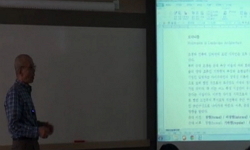In the pre-Qin period, Fa (伐) meant the exploit and its grades of the meritorious statesmen and counsellor, and Yue (閱) meant the resume. In the Qin-Han Dynasties, the two single words with different means were combined to a word ‘Fa Yue’ (伐...
http://chineseinput.net/에서 pinyin(병음)방식으로 중국어를 변환할 수 있습니다.
변환된 중국어를 복사하여 사용하시면 됩니다.
- 中文 을 입력하시려면 zhongwen을 입력하시고 space를누르시면됩니다.
- 北京 을 입력하시려면 beijing을 입력하시고 space를 누르시면 됩니다.

史學部 : 伐閱之源流與演變:以出土資料爲中心 = History : Studies on the Sources and Development of “FaYue”(伐閱): Focus on Unearthed Datum
한글로보기https://www.riss.kr/link?id=A100298433
- 저자
- 발행기관
- 학술지명
- 권호사항
-
발행연도
2014
-
작성언어
-
-
주제어
“Fa Yue” ; 伐閱 ; “Fa Yue” ; 閥閱 ; the wood manuscripts of Qin dynasty in Liye ; 裏耶秦間 ; the aristocratic families ; 世家大族 ; pedigree ; 門第 ; extraction ; 家世
-
KDC
900
-
등재정보
KCI등재
-
자료형태
학술저널
-
수록면
257-280(24쪽)
- 제공처
-
0
상세조회 -
0
다운로드
부가정보
다국어 초록 (Multilingual Abstract)
In the pre-Qin period, Fa (伐) meant the exploit and its grades of the meritorious statesmen and counsellor, and Yue (閱) meant the resume. In the Qin-Han Dynasties, the two single words with different means were combined to a word ‘Fa Yue’ (伐閱), which not only meant the exploit and resume, but also was a document recorded the notable achievements and the resumption. Especially the wood manuscript titled Fa Yue was unearthed in the first time at an abandoned well of Qin dynasty in Liye, Hunan Province. In this wood manuscript, the characters were written by three segments and the contents were composed that the official`s resume recorded by the time sequence which especially was accurate to the day in the different officials, his age and assessments about financial affairs and the household register and indicating what positions and institutions he will be promoted by the higher authority. The Wood Manuscript titled Fa Yue was not a copy but the real used document. It was important firsthand information to recognize the sources and development of Fa Yue in ancient China. In the East Han Dynasty, the structure of Fa (伐) was changed to Fa (閥) meanwhile the mean of ‘Fa Yue’ (閥閱) was changed to pedigree because the aristocratic families who holding high official and teaching the Confucian classics possessed the selection system and many Confucians acceded in the grass-rooted administrative system who could not obtain the military exploits and did not have the official experience .In the Wei, Jin, Southern and Northern Dynasties, ‘Fa Yue’ (閥閱) referred to extraction then it became the another appellation of blue blood in the Tang Dynasty. It was illustrated that the transformation of ‘Fa Yue’ (伐閱) to ‘Fa Yue’ (閥閱) was not only the change in word structure and means, but also miniatured the bureaucratic culture in the medieval China.
1 王彥輝, "<里耶秦簡(壹)>所見秦代縣鄉機構設置問題蠡測" 古代文明 2012 (4), 2012
2 曹旅寧, "<史律>中有關踐更規定的再探討"
3 程有為, "閥閱考辨" 史學月刊 1983 (6), 1983
4 晁福林, "金文“蔑曆”與西周勉勵制度" 歷史研究 2008 (1), 2008
5 陳偉, "里耶秦簡牘校釋(第一卷)" 武漢大學出版社, 2012
6 湖南省文物考古研究所, "里耶秦簡" 文物出版社, 2012
7 趙光賢, "釋蔑" 歷史研究 1956 (11), 1956
8 于省吾, "釋“蔑”" 東北人民大學人文科學學報 1956 (2), 1956
9 "通典"
10 "說文解字"
1 王彥輝, "<里耶秦簡(壹)>所見秦代縣鄉機構設置問題蠡測" 古代文明 2012 (4), 2012
2 曹旅寧, "<史律>中有關踐更規定的再探討"
3 程有為, "閥閱考辨" 史學月刊 1983 (6), 1983
4 晁福林, "金文“蔑曆”與西周勉勵制度" 歷史研究 2008 (1), 2008
5 陳偉, "里耶秦簡牘校釋(第一卷)" 武漢大學出版社, 2012
6 湖南省文物考古研究所, "里耶秦簡" 文物出版社, 2012
7 趙光賢, "釋蔑" 歷史研究 1956 (11), 1956
8 于省吾, "釋“蔑”" 東北人民大學人文科學學報 1956 (2), 1956
9 "通典"
10 "說文解字"
11 朱紹侯, "西漢的功勞閥閱制度" 史學月刊 1984 (3), 1984
12 唐蘭, "蔑新詁" 文物 1979 (5), 1979
13 "華陽國志"
14 于振波, "簡牘與秦漢社會" 湖南大學出版社, 2012
15 臧知非, "簡牘所見漢代鄉部的建制與職能" 史學月刊 2006 (5), 2006
16 戴衛紅, "簡帛研究二〇一三" 廣西師範大學出版社, 2014
17 汪桂海, "簡帛研究二〇〇一" 廣西師範大學出版社, 2001
18 大庭脩, "秦漢法制史研究" 上海人民出版社, 1991
19 安作璋, "秦漢官制史稿" 齊魯書社, 2007
20 張金光, "秦制研究" 上海古籍出版社, 2004
21 睡虎地秦墓竹簡整理小組, "睡虎地秦墓竹簡" 文物出版社, 1978
22 戴衛紅, "田餘慶先生九十華誕頌壽論文集" 中華書局, 2014
23 王彥輝, "田嗇夫、田典考釋———對秦及漢初設置兩套基層管理機構的一點思考" 東北師範大學學報 2010 (2), 2010
24 "潛夫論"
25 大庭脩, "漢簡研究" 廣西師範大學出版社, 2001
26 "漢書" 1962
27 邢義田, "治國安邦,法制、行政與軍事" 中華書局, 2011
28 閻步克, "樂師與史官——傳統政治文化及政治制度論集" 生活⋅讀書⋅新知三聯書店, 2001
29 張金光, "普遍授田制的終結與私有地權的形成——張家山漢簡與秦簡比較研究之一" 歷史研究 2007 (5), 2007
30 張光裕, "新見曶鼎銘文對金文研究的意義" 文物 2000 (6), 2000
31 "後漢書" 1987
32 廣瀨薰雄, "張家山漢簡<二年律令⋅史律>劄記"
33 王子今, "張家山漢簡<二年律令⋅史律>“學童”小議" 文博 2007 (6), 2007
34 廣瀨薰雄, "張家山漢簡所謂≪史律≫中有關踐更之規定的探討"
35 張家山二四七號漢墓竹簡整理小組, "張家山漢墓竹簡(二四七號墓釋文修訂本)" 文物出版社, 2006
36 謝桂華, "居延漢簡釋文合校" 文物出版社, 1987
37 李天虹, "居延漢簡簿籍分類研究" 科學出版社, 2003
38 永田英正, "居延漢簡研究(下)" 廣西師範大學出版社, 2007
39 胡平生, "居延漢簡中的“功”與“勞”" 文物 1995 (4), 1995
40 甘肅省文物考古研究所, "居延新簡,甲渠侯官與第四隧" 文物出版社, 1990
41 閻步克, "察舉制度變遷史稿" 遼寧大學出版社, 1992
42 萬斗雲, "夜郎國疆域考" 貴州民族研究 1988 (1), 1988
43 邱德修, "商周金文蔑曆初探" 五南出版社, 1987
44 "史記" 1982
45 南京市博物館, "南京市郭家山東晉溫氏家族墓" 考古 2008 (6), 2008
46 楊振紅, "出土簡牘與秦漢社會" 廣西師範大學出版社, 2009
47 徐中舒, "先秦史論稿" 巴蜀出版社, 1992
48 彭浩, "二年律令與奏讞書" 上海古籍出版社, 2006
49 金毓黻, "中國史學史" 商務印書館, 1957
50 "三國志"
51 鄔文玲, "“守”、“主”稱謂與秦代官文書用語" 出土文獻研究 12, 2014
동일학술지(권/호) 다른 논문
-
- 한국중국학회
- 왕비 ( Fei Wang )
- 2014
- KCI등재
-
어문학부(語文學部) : 중국(中國)고전시에 나타난 원추리 묘사 고찰
- 한국중국학회
- 배다니엘 ( Dan Iel Ba )
- 2014
- KCI등재
-
어문학부(語文學部) : 화동지역(華東地域) 제의연행에 보이는 서유기(西遊記) 서사(敍事)의 특징― 강소(江蘇) 남통(南通) 및 륙합(六合)의 “신서(神書)”를 중심으로
- 한국중국학회
- 이정재 ( Jeong Jae Lee )
- 2014
- KCI등재
-
語文學部 : 以“技擊”治學 -試論錢基博筆記體小說≪技擊餘聞補≫
- 한국중국학회
- 한지연 ( Ji Yeon Han )
- 2014
- KCI등재





 KISS
KISS




